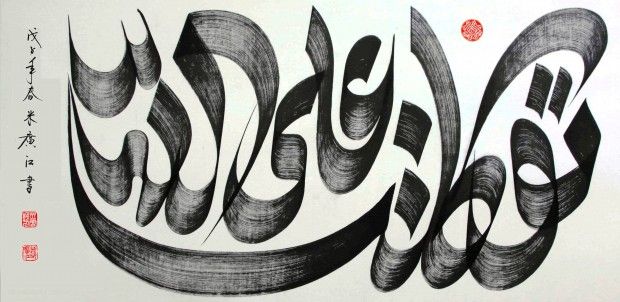Prachi Sahasrabudhe
Quran calligraphy, also known as Islamic or Arabic calligraphy, is a highly regarded art style distinguished by delicate and flowing forms. It is strongly ingrained in Islamic culture, and it has been used to transcribe and embellish lines from the Quran – ‘the holy book of Islam.’ It is used to write Arabic letters and words in an artistic way. Calligraphers were inspired by the Arabic language to create a traditional and contemporary calligraphy painting that expresses the aesthetic and spiritual aspects of Islamic art.
History and Origin:
Islamic or Arabic calligraphy also known as ‘khatt’ in Arabic derived from the words “line,” “design,” or “construction.” It is a significant
advancement in early Islamic civilisation and was created during the reign of Umayyad caliph Abd al-Malik. It is represented by a geometric writing style derived from the Semitic alphabet. The Quran and its language influenced a civilisation and culture that embraced Islam, and calligraphers’ major priority was to focus on beauty and perfection.
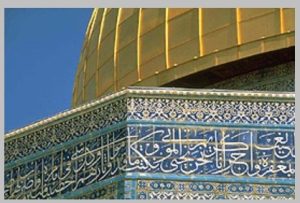
Jerusalem, https://www.webpages.uidaho.edu/
The Dome of the Rock in Jerusalem is an example of early Islamic calligraphy, and calligraphers such as Ibrahim Al Shajari and Hassan Al Basri began to enhance the writing of the Quran during the Umayyad era. Following the Umayyad era, Baghdad became the centre of calligraphy, where Dahak bin Ajlan and Ishaq bin Hammad rose to prominence.
Aesthetic and Compositional Arrangement:
Quran calligraphy is characterized by fluid and flowing lines, graceful interweaving of letters and geometric patterns. It emphasizes the use of geometric patterns and flowing lines to create harmonious compositions that express the message and beauty of the written word. Geometric principles are essential for Arabic calligraphy to form a sense of symmetry, based on the size of the alif, the first letter of the Arabic alphabet. Islamic calligraphy is an artistic expression that evolved after the Prophet Mohammad conveyed Islam’s message through the Quran. It adheres to the basic laws of Arabic script, writing from left to right with linear, curved, and dot letters. The letters are meticulously crafted with exact sizes and proportions, creating a visually balanced and pleasant arrangement.
Colour in the Holy Quran was a manifestation of miracles, artistic and aesthetic expression, and a verbal idiom that celebrated the book of God the Wise. Green is a symbol of Islamic culture, and it appears eight times in the Quran. Blue is a prevalent hue in Muslim civilization and can be found in many renowned mosques, including the Sultan Ahmed Mosque in Istanbul, Turkey. The colour red is referenced in the Quran as well, and it is related to mountains. Pink is referenced in the Quran as well, and it is related to rose-coloured skies. Gold and silver have a long tradition in Islamic art, particularly in Quran ornamentation.
Embellishments & Decorations:
Qur’an calligraphy is an artistic expression that typically includes decorative aspects such as flower motifs and arabesques. The written word is used to display the calligrapher’s skill. In Islamic calligraphy, floral motifs, arabesques, and complex border patterns are frequent decorative components. These embellishments provide visual interest and increase the overall aesthetic appeal of the artwork. 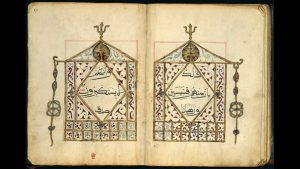
Lantern motif decoration from a 17th-century Chinese Qur’an, https://www.bl.uk/
Symbolism and Spiritual Meaning:
Islamic calligraphy is steeped in religious and cultural traditions. The Quran’s phrases and verses are frequently used in calligraphic compositions, imbuing the artwork with spiritual and symbolic value. Meliha Tepari says, when commenting on the visionary aspect of Islamic calligraphic art, that it has had a direct influence on its construction and aesthetics. Due to the impact of spirituality and the Divine message, it was often assigned a mystical dimension, and subsequently via Sufism, it was submerged in deep symbolism. Respect for holy people was one of the most fundamental aspects of Sufism, which was expressed in the art. Many notable calligraphic artists were Sufi teachers-mystics or their disciples who established canonical artistic norms. Tepari claims that letters in Islamic calligraphy have a magical aspect due to their distinctive shapes, distinct meaning and symbolism, and numerical worth. Since its beginning and through many forms of expression, calligraphic art has been mostly based on visions from the spiritual realm.
Role of Calligraphers:
Calligraphy, the art of beautiful writing with the reed pen, is both an act of worship and an art form in Islam. Banu Senay explores how the act of writing the Qur’an is a means through which the performative power of the text is reproduced. Calligraphers have extensive instruction to learn the art of handling the pen, comprehending scripts, and achieving precision in their works. To be admitted to this level, the scribe had to receive a diploma (ijazah) after several years of apprenticeship under a master calligrapher. Calligraphy is regarded as a highly valued art form, prized for its beauty, workmanship, and spiritual importance. It is still practised and praised all throughout the world, demonstrating the ongoing significance of this distinct creative legacy.
Styles of Scripts:
Islamic calligraphy is a type of devotion to the Qur’an, with regional differences in scripts, Arabic language, and varying materials and styles. During the Abbasid era, Islamic calligraphy and calligraphers became an important part of the state. Ibn Muqla, Yaqut al-Musta’simi, and Ibn al-Bawwab were pioneers of the set of the rule of calligraphy and are still celebrated today. Each script has distinct qualities and is used for a variety of purposes and circumstances. For example, Kufic is recognised for its angular and aggressive shapes, while Naskhi is more rounded and understandable. Thuluth is known for its grace and lengthy dimensions. After the Abbasid era, the Othman era began in 644, and the script of writing the Quran was developed. Yaqut al-Musta’simi was the fountainhead for Ottoman calligraphers, and the most sought-after accomplishment was copying the Quran and designing the inscription that decorated the interior of mosques. In Islamic calligraphy, several script styles are used, each having its own aesthetic attributes and historical importance. The primary styles of Islamic calligraphy can be classified as:
Naskhi – A cursive writing form that became the norm for reproducing the Quran and other writings. Naskhi was used for copying the Quran and was refined by Ibn al-Bawwab.
Kufic – Kufic is the oldest form of Arabic script, used at the time of the Prophet Mohammad. It was straight and rigid, without dots or accents, and was easy to use in stone carvings and coins. It was also used in Quran copying in the 8th-10th centuries.
Thuluth – An ornamental script used for heading or tile inscriptions.
Muhaqqaq – It was associated with writing most of the qur’anic scripts from the Mamluk period
Maghribi – Also known as the Western style. Muslim people in North Africa use it.
Nasta’liq – Persian style of calligraphy.
Diwani – Ottoman Turkish style.
Sini – Chinese style.
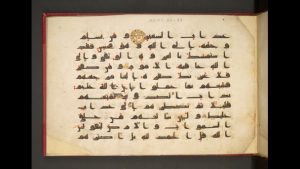 A 9th-century Qur’an in Kufic script, https://www.bl.uk/
A 9th-century Qur’an in Kufic script, https://www.bl.uk/
Between the 8th and 10th centuries, Kufic and an early version of Naskhi were in use. Naskhi was linked to administrative and commercial documents due to its readability. By the 11th century, the relationship between Naskhi and Kufic had matured and was seen as a conflict between text and adornment. Kufic was now used for decoration.
However, each script style mentioned above is distinct in its own way, ranging from angular and aggressive shapes to more rounded and cursive ones. Scripts in various styles and colours were used to highlight specific words or sentences to help the reader identify the hierarchy of texts where more than one text appeared on the page. An example of this is a Qur’an from India, which is written in black Naskhi script with its interlinear Persian translation written in red Naskhi script. Allah’s name is highlighted in blue throughout the text and in gold where it is mentioned in the pious invocation (basmalah).
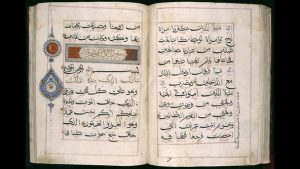 An early 16th-century Qur’an from India with Persian translation written in Bihari script, https://www.bl.uk/
An early 16th-century Qur’an from India with Persian translation written in Bihari script, https://www.bl.uk/
Grammatical Representation:
The oldest Qur’an codices were vertical in design, but early Qur’ans from the 9th and 10th centuries were written in Kufic script. The angular script was named after al-Kufah in southern Iraq, while the horizontal format was influenced by the shape of unrolled papyrus scrolls and rectangular wood and stone panels engraved with Qur’anic verses on mosque walls. Signs were added to the text to help with pronunciation. Abu al-Aswad al-Du’ali established a system of red dots to denote vowels and green dots to signify the glottal stop (Hamzah). To eliminate misunderstanding between similar-shaped characters, a system of short black diagonal strokes was devised in the eighth century. Since the 10th century, Qur’ans have been produced in a vertical configuration, emphasising the link between the physical shape of the volume and the script of the manuscript. The notation of vowel marks, invented by the 8th-century grammarian and philologist al-Khalil ibn Ahmad, began to emerge in Qur’an manuscripts. The prior system of simple red dots was now coupled with the vowel marks we are familiar with today.
Early Qur’an Calligraphy:
The earliest Qur’an manuscripts were made in the mid-to-late seventh century CE (1st century Hijrah). The so-called Ma’il Qur’an, which originates from the 8th century and comes from the Arabian Peninsula’s Hijaz region, is one of the earliest surviving Qur’ans. It is a nearly full codex and the greatest section of sequential Qur’an text that we have. The unusual characteristics of certain of its characters, particularly alif and ya’ (the beginning and end letters of the Arabic alphabet), help to identify the script. There are no textual cues to distinguish between letters of comparable form or to identify vowel sounds. To denote the conclusion of each verse, the early Qur’ans employed six tiny dashes. Later, to indicate the conclusion of each ten verses, red circles encircled by red dots were added, and chapter heads in a different script and colour were added. The name of the chapter, the number of verses, and whether it was revealed in Mecca or Medina were all indicated in the chapter titles.
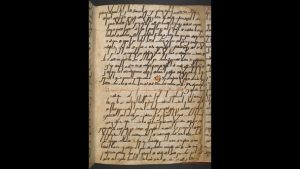 The British Library’s oldest Qur’an manuscript, Arabia, 8th century, https://www.bl.uk/
The British Library’s oldest Qur’an manuscript, Arabia, 8th century, https://www.bl.uk/
Qur’ans from China:
Muslim traders were already dealing in China in the eighth century, and a mosque was erected in 742. However, the influence of Islam in China and Central Asia was not felt until the 13th century, under the reign of the Mongols. Chinese Qur’an manuscripts are commonly referred to as Sini (‘Chinese’) Arabic because the pen strokes appear to have been influenced by Chinese calligraphy. A centre panel is a significant characteristic of Chinese Qur’ans’ adorned pages, which often include as little as three lines of text, each with only a few words. The adaption of Chinese art and cultural symbols is also seen in their decorating, such as a lantern motif in the final opening of a 17th-century Qur’an, which is emphasised by pendulous tassels linked to the hooks on the structures’ outer sides.
Calligraphy Painting:
Calligraphy painting is an artistic activity that uses Arabic characters, phrases, and colours to create a visual experience. In Islamic culture, calligraphy was utilised for presentation and visual art. Islamic calligraphy painting is a sacred art that has been practised for centuries by Muslim calligraphers. Other subject matters such as sculptures, paintings, and images of people and animals are not appreciated in Islam, so Islamic calligraphy artistically displays the words and verses of the Quran, which is God’s word, to decorate buildings, books, places of worship, and other public and private displays. It is used to write verses from the Quran and words from the prophet, known as Hadith. It involves a long process of drawing letters and requires a lot of practice. Modern calligraphers who are influenced by traditional calligraphy use strict and well-established regulations and rules. Both traditional and contemporary calligraphers base their work on the sacred words of the Quran by contemplating the meaning of the passages. Islamic calligraphy painting approaches the Arabic language from a different angle, yet all calligraphers, whether traditional or contemporary, reproduce their paintings using the Islamic calligraphy style of writing as a starting point and source of inspiration. Painting with calligraphy offers a sense of global spirituality and reveals the holy language that preserves God’s word.
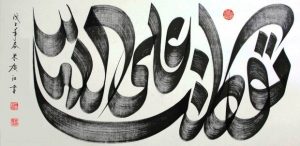 Haji Noor Deen, “My trust in Allah,” Ink on Paper, 230 cm X 102 cm, www.hajinoordeen.com
Haji Noor Deen, “My trust in Allah,” Ink on Paper, 230 cm X 102 cm, www.hajinoordeen.com
Islamic or Qur’an calligraphy exemplifies both the aesthetic qualities of Islamic culture and the simplicity and intricacy of Islamic art. It also depicts the spiritual essence of Islam in a magnificent style of art.
***
References:
Alashari, D. M., Hamzah, A. R., & Marni, N. (2019). Islamic art and language as a source of inspiration leading to traditional Arabic calligraphy art. UMRAN-International Journal of Islamic and Civilizational Studies, 6(3), 33-45.
Alashari D. M., Hamzah, A. R., & Marni, N. (2020). The journey of Islamic art through traditional and contemporary calligraphy painting. UMRAN-International Journal of Islamic and Civilizational Studies, 7(3), 1-11.
Senay, B. (2017). Textual ecologies in Islam: improvising the perfect Qur’an in Calligraphy. Journal of religious and Political Practice, 3(1-2), 46-56.
Teparić, M. (2013). Islamic calligraphy and visions. Ikon, 6, 297-306.
Baker C.F., 23 September 2019, “Calligraphy of the Qur’an”, British Library, https://www.bl.uk/sacred-texts/articles/calligraphy-of-the-quran
Maragha A., 5 October 2022, “Islamic Calligraphy Art & Styles”,
https://study.com/academy/lesson/calligraphy-in-islamic-art-definition-styles-uses.html
You may also like
Where Words Become Art in Letter and Spirit: The Performative Power of Islamic Calligraphy
May 24, 2023
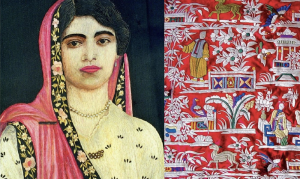
Columns Featured Room For More Art
The Chinese Connection of Parsi-Gara Embroidery
May 24, 2023
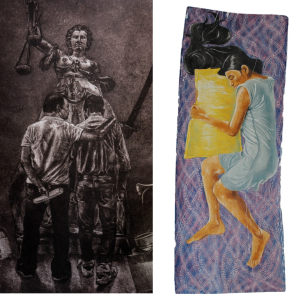
Exhibitions
Abir Space Celebrating Printmaking: Digital Exhibition “Kabir se Abir tak” till 5th July
May 22, 2023


